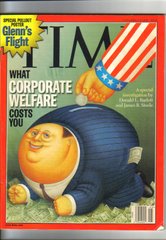By Manifesto Joe
Food stamps have been distributed in the U.S. since the 1960s. I'm fortunate enough to have never needed them -- although my family had a very close scrape, when my dad became terminally ill and disabled when I was 11. One thing I've learned is that things have to go very badly, for a while, for one to even qualify for the program.
Those who follow business news have no doubt heard the bad news about economic indicators such as retail sales, durable goods orders and the like. I propose to add one to the list: food stamp use. It is projected to reach, this year, its highest level since the program started over 40 years ago. I'll repeat -- just qualifying for this program is tough. So this is a very significant economic development.
This is from today's New York Times:
Driven by a painful mix of layoffs and rising food and fuel prices, the number of Americans receiving food stamps is projected to reach 28 million in the coming year, the highest level since the aid program began in the 1960s.
The number of recipients, who must have near-poverty incomes to qualify for benefits averaging $100 a month per family member, has fluctuated over the years along with economic conditions, eligibility rules, enlistment drives and natural disasters like Hurricane Katrina, which led to a spike in the South.
But recent rises in many states appear to be resulting mainly from the economic slowdown, officials and experts say, as well as inflation in prices of basic goods that leave more families feeling pinched. Citing expected growth in unemployment, the Congressional Budget Office this month projected a continued increase in the monthly number of recipients in the next fiscal year, starting Oct. 1 - to 28 million, up from 27.8 million in 2008, and 26.5 million in 2007.
Federal benefit costs are projected to rise to $36 billion in the 2009 fiscal year from $34 billion this year.
"People sign up for food stamps when they lose their jobs, or their wages go down because their hours are cut," said Stacy Dean, director of food stamp policy at the Center on Budget and Policy Priorities in Washington, who noted that 14 states saw their rolls reach record numbers by last December.
One example is Michigan, where one in eight residents now receives food stamps. "Our caseload has more than doubled since 2000, and we're at an all-time record level," said Maureen Sorbet, spokeswoman for the Michigan Department of Human Services.
Officially, U.S. unemployment isn't very high now. To wit, from the Bureau of Labor Statistics on March 7:
Nonfarm payroll employment edged down in February (-63,000), and the
unemployment rate was essentially unchanged at 4.8 percent, the Bureau of
Labor Statistics of the U.S. Department of Labor reported today. Employment
fell in manufacturing, construction, and retail trade. Job growth continued
in health care and in food services.
With a 4.8% jobless rate, there is now more food stamp use, both in totals and in percentage of the population, than during the now-underestimated recessions of the mid-'70s and the early '80s. Back then, joblessness sometimes topped 10 percent. I recall those recessions well -- I was in college working summer jobs during the first, and a recent M.A. graduate looking for work during the second. I think there's something wrong with this picture. Why wasn't food-stamp use greater then than it is now?
Let's read between the lines. "Employment fell in manufacturing, construction, and retail trade. Job growth continued in health care and in food services."
A lot of this probably has to do with the types of jobs people can get now, and how the U.S. economy has been essentially restructured for wage- and salary-busting.
Fewer jobs in unionized manufacturing -- they're being rapidly offshored to nonunion and lower-wage settings. Fewer jobs in construction -- those jobs tend to pay well while they last, but when they're not there, times get tough. Retail -- people have to have money to buy things.
On the plus side: health care? I've spent enough time monitoring elderly people at nursing homes and assisted-living facilities to know that many of the workers are barely getting minimum wage. Food services? Forget it. In college, I had a girlfriend who was a waitress, and she complained about the pay and tips even back then, in a college town. You won't make much unless you're a certified chef, or better still, if you own that relatively rare asset that is a successful eatery.
As for the unemployed -- the stats reflect only those we know about. Not reflected are those who have, in despair, quit looking for work. Nor do they include those who have found some niche in the underground economy.
I would dare say that another factor is the so-called "welfare reform" by the Congress in 1996. The welfare rolls are indeed down sharply -- but people still feel the urge to eat. Forced to work in low-wage jobs, the erstwhile recipients generally still need the food subsidy. And, by the way, with all those new people dumped into the low-wage labor pool over the past 12 years, is it surprising that wages have declined? And with that, food-stamp use has increased?
And of course, let's not forget what effect the subprime mortgage crisis has probably had on millions of family situations. I suspect it hasn't helped.
I've had enough dealings with the business press to know that my proposal here will never fly. But I'll have a go at the windmill anyway. Food-stamp use should be included on the list of leading economic indicators. Perhaps our business-page readers should know how things are going for the bottom 10 percent, not just the fat cats.
Manifesto Joe Is An Underground Writer Living In Texas.
Subscribe to:
Post Comments (Atom)




















1 comment:
The government spends around $28 billion a year on the food stamp program.
Sounds like a lot until you consider that the Fed spent $30 billion of our taxpayer dollars in bailing out the rich, reckless investors at Bear Sterns.
$28 billion is what we spend in a little over two months on the Iraq fiasco.
Another point is this: there are tens of millions of low-income Americans who have never received food stamps.
I once did a story on poverty in North Texas when I was a reporter. None of the families I interviewed had ever received food stamps. Several of them had applied, but were rejected for various Catch-22 bureaucratic reasons. Most of them worked two and three jobs, just to survive.
Post a Comment